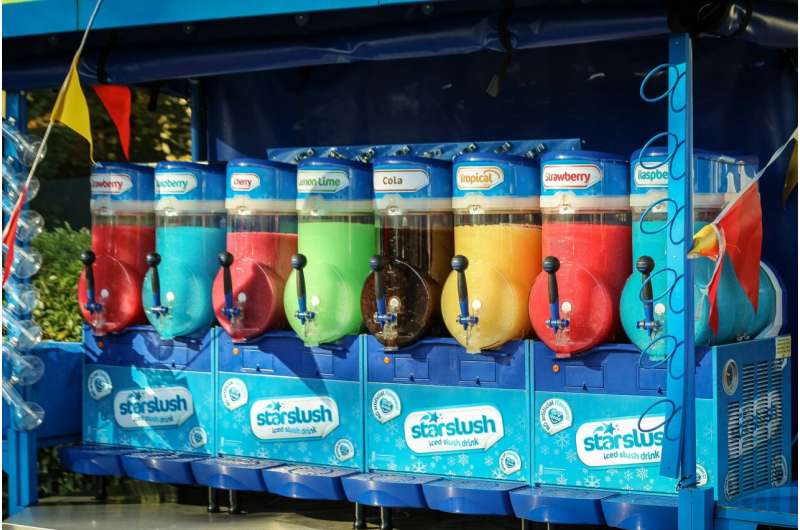This article has been reviewed according to Science X's editorial process and policies. Editors have highlighted the following attributes while ensuring the content's credibility:
fact-checked
trusted source
written by researcher(s)
proofread
Are slushies really bad for young children's health?

Recently there have been concerning reports in the news of a three-year-old boy who collapsed and was admitted to hospital after drinking a slushy drink. Fortunately, after a few days, the child recovered completely.
This has led to calls for improved labeling where slushies are sold so that parents are better educated about the potential risks to young children consuming these drinks. It has also led to calls for the drinks to be removed from sale at certain venues, such as soft-play centers.
This follows from reports of three other young children being admitted to hospital following consuming slushy drinks containing glycerol, which in 2023 led to the Food Standards Agency in the UK reviewing the safety of glycerol in slushies. These children had low blood glucose and high levels of glycerol before recovering.
This led to the recommendation that slushy drinks containing glycerol should not be offered to children aged four years and younger.
Using these figures it was also recommended that children under ten should not be offered free refills. This advice also includes the recommendation that these customers should be informed of these risks and restrictions for young children, but no recommendations were made about restricting where they could be sold.
What is glycerol?
Glycerol also known as glycerine or E422 is recognized as being generally safe as a food additive by the EU and the US Food and Drug Administration. Chemically, it is described as a sugar alcohol.
Aside from slushies, glycerol is also found in flavorings such as vanilla essence and is often used to keep icing soft.
Normally, in our bodies, glycerol is connected to fatty acids, so levels in the blood are low. Also, our bodies do not have a way of regulating or controlling glycerol in the same way we produce insulin to control glucose (blood sugar). So there is no way for our body to simply start using more glycerol in cells in the way we can with glucose after a meal.
This does not mean glycerol is toxic, it just means it can stay in blood for longer than glucose. As this adds to the amount of things dissolved in our blood, it means the plasma in blood becomes more concentrated and can draw water from other parts of the body, including the brain, which can lead to symptoms such as headache, nausea and dizziness.
Why use glycerol in slushies?
How slushies are made has changed, at least partly in response to a UK government policy on sugar reduction and the Soft Drinks Industry Levy (the "sugar tax"). Where most sweetened soft drinks, were able to use a mix of low- and no-calorie sweeteners—such as aspartame—this doesn't work when it comes to slushies.
The challenge when making slushies, compared to normal soft drinks, is the sugar does more than provide sweetness. Sugar has the physical function in slushies of decreasing the freezing point of water. Water freezes at 0°C, but adding sugar reduces the ability of the water molecules to connect by hydrogen bonds and form ice.
Adding sugar to water and churning as the temperature drops below zero produces slush rather than ice. To do this, you need at least 12g of sugar per 100ml, which would mean sugar-containing slushies would be liable for the highest rate of tax at 24p per litre in the UK.
In line with sugar reduction strategies, aimed at helping people consume the target set by the government's Scientific Advisory Committee on Nutrition of less than 5% of energy from added sugar, manufacturers have looked for another solution.
In a slushy, intense sweeteners, such as aspartame, won't work as it is a very intense sweetener being 200 times sweeter than sugar. So you can't just swap out sugars for aspartame. A different solution is needed, one where a similar quantity of sweetener is used compared with sugar. These so-called bulk sweeteners, such as sorbitol and mannitol, can have a laxative effect, so they aren't great options.
Glycerol was the chosen solution, which can make a slushy with around 5g per 100ml. But is that amount safe to consume?
European Food Safety Agency reassessed the safety of glycerol in 2017. It reported that consuming 125mg per kilogram of body weight per hour was enough to increase the concentration of blood and potentially cause symptoms in patients. This was based on how glycerol was used in the past to treat swelling in the brain (cerebral oedema). However, there is little data on the effect of glycerol outside of hospitals, and it was assumed that this level of intake could be linked to potential risks.
For an adult, there are no risks of drinking an average-sized slushy, simply because they are bigger and unlikely to achieve a blood level high enough to bring on symptoms. But for a young child, because of their size, it was considered that the risk was deemed high enough for warnings to be issued.
However, the Food Standards Agency's response and recommendations to restrict the supply of slushies to young children could benefit from being more clearly communicated and more effectively applied.
This article is republished from The Conversation under a Creative Commons license. Read the original article.![]()


















